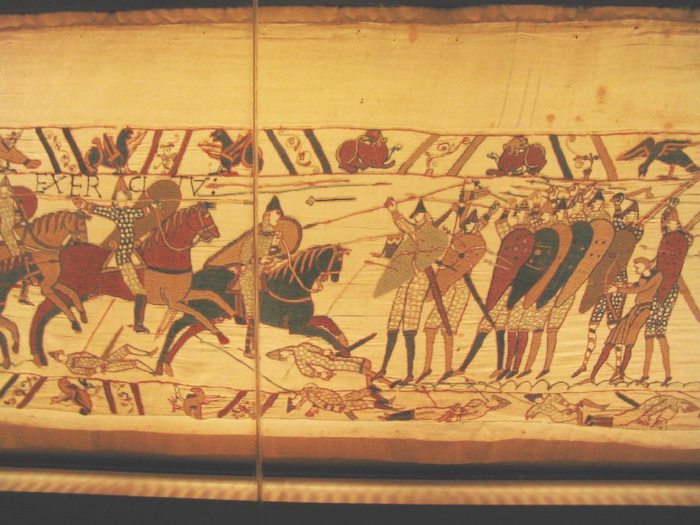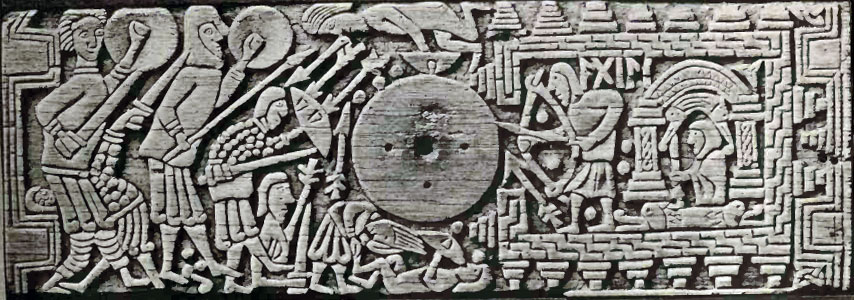Exeter Riddle 23
MEGANCAVELL
Date: Thu 15 May 2014Matching Commentaries: Commentary for Exeter Riddle 23
Agof is min noma eft onhwyrfed;
ic eom wrætlic wiht on gewin sceapen.
Þonne ic onbuge, ond me of bosme fareð
ætren onga, ic beom eallgearo
5 þæt ic me þæt feorhbealo feor aswape.
Siþþan me se waldend, se me þæt wite gescop,
leoþo forlæteð, ic beo lengre þonne ær,
oþþæt ic spæte, spilde geblonden,
ealfelo attor þæt ic ær geap.
10 Ne togongeð þæs gumena hwylcum,
ænigum eaþe þæt ic þær ymb sprice,
gif hine hrineð þæt me of hrife fleogeð,
þæt þone mandrinc mægne geceapaþ,
fullwered fæste feore sine.
15 Nelle ic unbunden ænigum hyran
nymþe searosæled. Saga hwæt ic hatte.
Wob is my name turned back;
I am a wondrous being, shaped for battle.
When I bend, and from my bosom travels
a poisonous dart, I am very ready
5 so that I sweep that deadly evil far away from me.
When my ruler, he who designed that distress,
looses my limbs, I am longer than before,
until I spit, debased by destruction,
the terrible poison that I took in before.
10 What I speak about here does not
easily pass away from anyone,
if that which flies from my belly strikes him,
so that he buys that evil drink with his strength,
[pays] full compensation with his very life.
15 Unbound, I will not obey anyone
unless skillfully tied. Say what I am called.
Notes:
This riddle appears on folio 106v of The Exeter Book.
The above Old English text is based on this edition: Elliott van Kirk Dobbie and George Philip Krapp, eds, The Exeter Book, Anglo-Saxon Poetic Records 3 (New York: Columbia University Press, 1936), page 192.
Note that this edition numbers the text Riddle 21: Craig Williamson, ed., The Old English Riddles of the Exeter Book (Chapel Hill: University of North Carolina Press, 1977), page 81.
Tags: anglo saxon exeter book riddles old english solutions riddle 23
Related Posts:
Exeter Riddle 25
Exeter Riddle 40
Exeter Riddle 73


Commentary for Exeter Riddle 22
MEGANCAVELL
Date: Wed 07 May 2014Matching Riddle: Exeter Riddle 22
This riddle’s commentary is a guest post from the stellar David Callander. David is a PhD student at the University of Cambridge, where he works on early medieval Welsh and English poetry. Take it away, David!
If you’re anything like me, this riddle will have completely foxed you. Different possibilities are gradually taken away until we’re left wondering, what on earth could this be? Or not on earth, perhaps.
First of all, we’re told that we’re dealing with LX men riding on horseback (Arabic numbers weren’t used in England yet, so the residents of early medieval England were stuck with Roman numerals.) Instead of moving on to describe different aspects of these men, we’re told a short story about them trying to cross a river. They want to cross this river, but are held back by the atol yþa geþræc, the ‘terrible tumult of the waves’. So then this wægn (it is what it looks like) turns up and, with a conveniently introduced pole, both ‘mounts and men’ are borne cheerfully over the water. But they do this in a seemingly impossible way – it did not disturb the water, nor fly in the air (so the Wind’s out), and also they weren’t pulled by the strength of slaves, or beasts of burden (13-14). This concludes with a happy ending, the men and horses have reached the greener grass of the far bank gesund (‘unharmed’ – the word is still used in Modern German and forms the first part of Gesundheit.) To me it all sounds a bit like punting.
Photo (by Evans1551) from Wikimedia Commons (licence: CC BY-SA 3.0).
So, a lovely story, but we aren’t really left any the wiser as to what is being described, and there’s just so much going on! What are the men and horses, and what’s the teleporting wagon doing? And why are there sixty men, eleven with noble steeds and four with white ones? Presumably the rest had to make do with tiny Viking horses:
Photo (by Andreas Tille) from Wikimedia Commons (licence: CC BY-SA 3.0).
Well, as you might expect, scholars have been arguing about this for at least 150 years. What can cross water, but not in the sky nor through the water itself? We are compelled to look up.
For some of us nowadays, it can be easy to forget the stars. But for the people of early medieval England they would have been vivid in the unclouded sky, without fumes and smog to blot them out. The constellation we now know as the Big Dipper (Ursa Major) was then known as Carles wæn (literally "a churl’s wagon"). This seems to have represented a wagon with a single pole, as L. Blakeley explains. Ælfric refers to how this constellation goes up and down both by day and by night in his De temporibus anni. The constellation under the “Wain” (Canes Venatici) consists of eleven stars visible to the naked eye, four of which Blakeley sees as particularly bright (the eleven noble steeds and four white ones.) Patrick Murphy has preferred to see the constellation Draco here, which, conveniently, consists of fifteen stars.
Can you see it? Photo (by adkiscool) from Deviant Art.
But why sixty horsemen altogether? Marijane Osborn makes the ingenious suggestion that this refers to sixty days after the winter solstice, when the position of the Big Dipper in relation to the pole would mark the seasons, or it could just be used more loosely to refer to many stars. Like other Old English riddles, this poem might draw upon Aldhelm’s Latin riddles (Riddle 53 in particular, which also refers to the Wain.)
Other solutions have been suggested, such as "month" and "bridge." A "month" (December in particular) was the earliest proposed solution, with the sixty days referring to the half-days of the month. It runs into a bit of trouble because it relies on counting feast days (seven) and Sundays (four, although there could be five) in terms of full days, rather than half-days like the other days of the month. It seems a bit of a leap to take this out of the riddle. A "bridge" would certainly have allowed the horsemen to cross the river without disturbing the water. But how would this explain the horsemen? And why would they have been stuck on one side of the water if there was already a bridge there?
One last tantalizing titbit. Classical writers refer to the Big Dipper as a plough (the constellation Boötes being the ploughman.) If we look at the first three riddles of the Exeter Book (unless we see them as one super-riddle), it seems that some of the riddles have been grouped together by theme. I wonder whether the idea of the Big Dipper as a plough was in the mind of a compiler when he decided to place the text after Riddle 21 (the Plough)?
References and Suggested Reading:
Ælfric. De Temporibus Anni. Ed. Heinrich Henel. Early English Text Society, vol. 213. Oxford: Oxford University Press, 1942, section 9.6.
Blakeley, L. “Riddles 22 and 58 of the Exeter Book.” Review of English Studies, new series, vol. 9 (1958), pages 241-7.
Murphy, Patrick J. Unriddling the Exeter Riddles. PA: Pennsylvania State University Press, 2011, pages 111-23.
Osborne, Marijane. “Old English Ing and his Wain.” Neuphilologische Mitteilungen, vol. 81 (1980), pages 388-9.
Williamson, Craig, ed. The Old English Riddles of the Exeter Book. Chapel Hill: University of North Carolina Press, 1977, pages 201-4.
Tags: anglo saxon exeter book riddles old english solutions riddle 22 david callander
Related Posts:
Commentary for Exeter Riddle 53